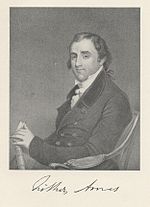Talk:History of Dedham, Massachusetts/draft
| Part of a series on the |
| History of Dedham |
|---|
 |
| Main article |
| Dedham, Massachusetts |
| By year |
| By topic |
The town of Dedham, Massachusetts (in the United States) has a long and storied history.
Pre-colonial
[edit]Before the colonization of North America, the area that became Dedham was settled by the Massachusett and Wampanoag tribes. The Neponset tribe settled near a body of water in Dedham now known as Wigwam Pond.[1]
17th century
[edit]Dedham was "planted" in 1635,[2] and was formally settled as its own town in September 1636.[3]: 318 [4]: 547 The original tract of land granted to Dedham stretched for some 177 square miles,[4]: 547 (roughly 20 miles long and 10 miles wide)[2], extending from modern-day Roxbury and Dorchester to the Rhode Island state border.[2] Despite this, most people lived near 1.5 miles of the town center until 1682.[4]: 547
The town remained primarily agricultural until the 19th century.[3]: 318
The town grew rapidly over the course of the 17th century. In 1648, the population was roughly 400 people; in 1700, the population was roughly 750.[3]: 326 Roughly 25% to 40% of the people of Dedham at any given time were new arrivals who did not live there during the previous decade, most of which were close relatives of Dedham's families.[3]: 322–323 (The data is distorted by the towns separated out of Dedham.[3]: 322–323 )
The town of Medfield, Massachusetts was split out of Dedham in 1649–51. Wrentham, Massachusetts was split out of Dedham in 1669–73.[3]: 322
Early lifestyle
[edit]This section is empty. You can help by adding to it. (December 2023) |
Early government
[edit]18th century
[edit]Dedham grew further in the 18th century. Its population reached 1,500 people around 1750, and almost 2,000 by 1775.[4]: 547
Three more towns were separated from Dedham in the 18th century with little opposition: Needham in 1711, Bellingham in 1719, and Walpole in 1724.[3]: 323 [4]: 548 By 1725, however, Dedham was much smaller than it had been, and people started questioning whether to break up the town further.[4]: 548
In the American Revolution
[edit]In the Woodward Tavern (where Fisher Ames was born), a convention met in September 1774 and adjourned to Milton, where it passed the Suffolk Resolves.[2]
19th century
[edit]The Dedham Public Library was organized in 1854 and incorporated in 1871.[2] The Dedham Historical Society was organized in 1859 and incorporated in 1862.[2]
In the Civil War
[edit]This section is empty. You can help by adding to it. (December 2023) |
20th century
[edit]As of the 1910 census, the town was home to 9,284 people.[2] The 1911 Encyclopedia Britannica described the town's economy as follows: "Carpets, handkerchiefs and woollen [sic] goods are manufactured, and a pottery here is reputed to make the only true crackleware outside the East."[2]
21st century
[edit]This section is empty. You can help by adding to it. (December 2023) |
References
[edit]- ^ Coughlin, Gail. "Dedham's Indigenous Histories" (PDF). www.dedhammuseum.org. Archived (PDF) from the original on September 21, 2023. Retrieved December 23, 2023.
- ^ a b c d e f g h Chisholm, Hugh, ed. (1911). . 1911 Encyclopædia Britannica (11th ed.). Cambridge University Press – via Wikisource.
- ^ a b c d e f g Lockridge, Kenneth A. (1966). "The Population of Dedham, Massachusetts, 1636-1736". The Economic History Review. 19 (2): 318–344. doi:10.2307/2592255. ISSN 0013-0117.
- ^ a b c d e f Cook, Edward M. (1970). "Social Behavior and Changing Values in Dedham, Massachusetts, 1700 to 1775". The William and Mary Quarterly. 27 (4): 546–580. doi:10.2307/1919704. ISSN 0043-5597.
Further reading
[edit]- Smith, Frank (1936). A History of Dedham, Massachusetts. Transcript Press, Incorporated.
- Lockridge, Kenneth A. (1970). A New England Town: The First Hundred Years, Dedham, Massachusetts, 1636-1736. Norton. ISBN 978-0-393-05381-4.
- Hanson, Robert Brand (1976). Dedham, Massachusetts, 1635-1890. Dedham Historical Society.

